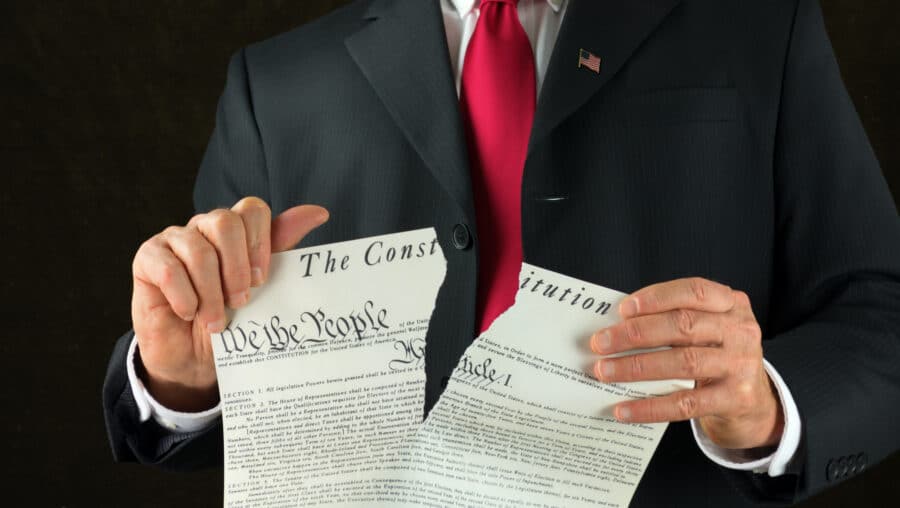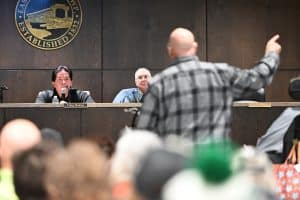This article was originally published by the Center for Media and Democracy.
Several groups affiliated with the American Legislative Exchange Council (ALEC) have been waging a well-funded campaign to call a convention under Article V of the U.S. Constitution to amend our Constitution. The Heritage Foundation, the prime force driving Project 2025, has strongly endorsed the effort to call an Article V convention.
A study by the Center for Media and Democracy concluded Republicans would have sole control over the membership of 29 of the fifty state delegations – with another two likely split between the parties – meaning that they could write amendments as they saw fit without any need to compromise with Democrats or independents.
Although ALEC and its allies speak in generalities about what they would seek to accomplish in a convention — using vague terms such as “fiscal responsibility” and limiting “federal overreach” — they clearly see an Article V convention as a crucial vehicle for enacting the same radical agenda that drove Project 2025. Indeed, ALEC serves on the advisory board for Project 2025.
These intentions are evident from the enormous resources ALEC’s funders are devoting to pushing for an Article V convention and from the amendments proposed by the mock conventions they have convened. The most recent of these was the Convention of States’ (COS) August 2023 mock convention in Colonial Williamsburg, Virginia, bringing together mostly Republican legislators from 49 states:
– Echoing the Project 2025’s radical proposals (at pp. 531-32) to transfer federal wildlife habitats to extractive industries, COS’s “Federal Legislative & Executive Jurisdiction Proposal 3” would compel the federal government to transfer large swaths of federal lands to the states. Under this constitutional amendment, the federal government would require past or future permission from state legislatures to retain almost any of the land it holds within their boundaries apart from national parks, monuments, and wilderness areas that have existed since at least 1976.
– Project 2025 seeks to undermine civil rights, demanding an end to energetic enforcement of the rights of people seeking to access abortion clinics (at pp. 557-58) and redirecting the Civil Rights Division of the Justice Department to attack diversity programs (at pp. 560-62). COS’s “Federal Legislative & Executive Jurisdiction Proposal 1” goes even farther, eliminating the constitutional authority for most civil rights laws by sharply restricting Congress’s authority to regulate interstate commerce to “buying, selling, or transportation of commercial goods and services across state lines.” All existing laws and regulations exceeding this authority, including the Civil Rights Act of 1964 and the Fair Housing Act of 1968, would be nullified in two years.
– This same COS proposal to radically restrict Congress’s authority to legislate under the Commerce Clause would realize Project 2025’s goal (at pp. 60-61, 422-40 and 533-36) to gut federal environmental protection. Much or all of the National Environmental Policy Act (NEPA), the Endangered Species Act, and other major environmental laws that Project 2025 targets are grounded in the Commerce Clause and would be abolished in two years under COS’s proposal.
– Numerous proposals in Project 2025 seek to maximize the impact of recent decisions by the stacked U.S. Supreme Court or demand further radical changes to empower the president that a new administration should seek from this Court (e.g., at pp. 560 and 586). COS’s “Federal Term Limits & Judicial Jurisdiction Proposal 2” would permanently limit the Court to nine justices, precluding any legislation to expand the Court and restore its balance.
– Project 2025 demands that a balanced federal budget be a paramount objective (at p. 702) while proposing numerous tax changes that would reduce what the affluent pay (at pp. 695-701). This would require staggering reductions in domestic spending. Project 2025 (at p. 379) and other proposals from Trump advisors seek to have the president unilaterally rescind appropriations for programs they dislike. President Nixon tried this and lost repeatedly in court, including the U.S. Supreme Court’s effectively unanimous decision in Train v. City of New York. COS’s “Fiscal Restraints Proposal 1” would cap federal spending at the average of the previous three years’ revenues, requiring these same massive cuts, and providing a possible constitutional basis for unilateral presidential rescissions.
– Project 2025 proposes that 3/5 majorities of both chambers of Congress be required to increase taxes (at p. 698).This same COS proposal outdoes Project 2025 by locking into the Constitution a requirement of 2/3 majorities in both chambers of Congress to increase taxes.
Unlike Project 2025, an Article V convention does not require former President Trump to defeat Vice President Harris. If Republicans retain control of the U.S. House of Representatives and seize the U.S. Senate, they likely will seek to call an immediate Article V convention. The President has no power to veto such an action. Even if Democrats do relatively well in state legislative elections, Republicans likely would still have complete control of a solid majority of the delegations to an Article V convention. Calling an Article V convention will prove especially attractive to congressional Republicans if a Harris victory prevents them from achieving many of Project 2025’s other objectives directly.
The key to preventing a new Republican majority in Congress from calling an Article V convention is to deny them enough state applications to be able to make a credible claim that two-thirds of the states have applied for one, as the Constitution requires. Although the ALEC-allied groups are well short of two-thirds of the states on any honest measure, ALEC and one of the lawyers involved in the 2020 fake electors scheme have been devising exotic legal theories that would allow them to count states’ old, moot, and unrelated convention calls toward the 34-state threshold.






